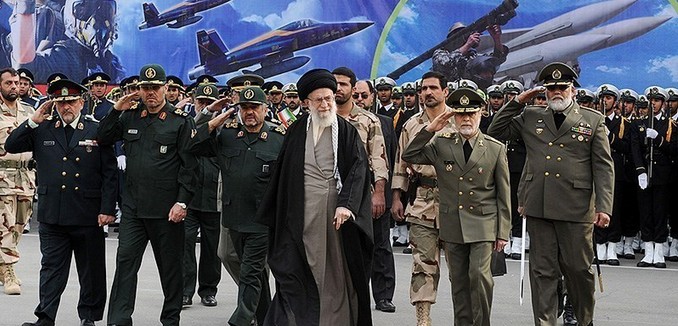Iran’s recent establishment of a United Shi’a Liberation Army is raising concerns that Tehran will further stoke sectarian violence across the Middle East in its pursuit of regional dominance, Radio Free Europe reported on Tuesday.
Iran’s August 25 announcement of the formation of a new fighting force with a Shi’ite identifier in its name “will inflame sectarian tensions in the region,” said Tallha Abdulrazaq, a researcher at the University of Exeter. “Iran is asserting itself as a regional or even an imperialistic power,” he added.
“They are basically declaring that they are going to continue to use foreign fighters to spread sectarian violence, extremism, and terrorism across the region,” Abdulrazaq explained.
Rasool Nafisi, a Middle East affairs expert at Strayer University, said, “Tehran and Riyadh have locked horns for months now, and this could be a muscle-flexing gesture by Iran, giving a signal to Saudis that Iran might use all of its potentials in that fight.” The announcement of a Shi’ite army “could be more than a provocative act to Saudis and other Sunni states in the region and could be in line with Iran’s further ambitions in the region,” he added.
Mohammad Ali Falaki, a retired Islamic Revolutionary Guard Corps general who was pressed back into service to lead the new army, recently said that his force will focus on fighting in Yemen, Iraq, and Syria in the immediate future. Falaki also declared that his army’s goal was to destroy Israel within 23 years.
Maysaa Shuja Aldeen, a Cairo-based expert on Yemen, said that the new Shi’ite army will “only exacerbate the conflict in Yemen,” where Shi’ite Houthi rebels are fighting with Iranian support. “Houthis are one of the most organized groups in the Yemeni war, and any additional support would empower them on the ground,” he explained.
Sardar Kazemi, a former Afghan fighter who later defected and sought asylum in UAE, said that Iranian commanders in Syria “lead the battles in defending the Damascus regime. Syrians and other fighters from Lebanon and Afghanistan are fighting under their command.” Iran has boosted IRGC forces with Shi’ite fighters recruited, often forcibly, from Afghanistan and Pakistan.
Thousands of fighters from Iran-backed Shi’ite militias, called popular mobilization forces, are currently battling the Islamic State in Iraq. The forces, which are led by IRGC-Qods Force commander Qassem Soleimani, are also widely suspected of committing atrocities against Iraq’s Sunni Muslim minority.
While Iran has been controlling these forces for some time, The Wall Street Journal reported in February that Tehran was using “Shiite proxies to bolster its reach and influence” across the Middle East.
In Meet the Proxies: How Iran Spreads Its Empire through Terrorist Militias, which was published in the March 2015 issue of The Tower Magazine, David Daoud summed up the dangers posed by Iran’s proxy militias.
With their ideological allegiance to Iran and the concept of Absolute Wilayat al-Faqih; their ideologically motivated hostility to the United States, the West, and its allies; and their list of human rights atrocities and terrorist acts over the course of the last three decades, one would assume that these groups would be sidelined and marginalized, if not placed in the same category as ISIS.
Yet, the opposite seems to be true. General Martin Dempsey, the former supreme commander of U.S. forces in Iraq, has said that the expansion of “Iranian influence will be a net positive.” Making matters worse, President Obama’s desired Authorization for Use of Military Force (AUMF) against ISIS and its accompanying explanatory letter propose using American forces in a support role for “our partners on the ground” and “local forces.” Any astute observer of the Iraqi and Syrian battlefield can readily see that Iran’s Shi’a militia proxies are the only groups fitting those descriptions that are leading the fight against ISIS. In effect, with the best of intentions, the AUMF is calling for the inadvertent support of some of the United States’ staunchest enemies.
Despite the old adage “the enemy of my enemy is my friend,” such a policy can only backfire. Every inch of territory acquired by these groups has not been liberated from ISIS occupation, but conquered by Iran, which is a far more formidable enemy. Such a strategy is counterproductive, and supporting groups committing unspeakable atrocities against Sunnis is not a viable alternative to fighting ISIS. It will only add fuel to the sectarian fires already raging in Iraq and elsewhere, severely hindering U.S. foreign policy goals in the region. The same applies in Yemen, where the United States turned its back on its ally, President Abed Rabbo Mansour al-Hadi, and after signaling its openness to working with the Houthis, actually formed indirect ties with them, according to the White House and the group’s commanders. Houthi commanders said the U.S. has indirectly provided them with intelligence and logistical support against AQAP. This happened despite the group’s allegiance to Tehran, opposition by Saudi Arabia and the fact that the group stands poised to ignite heretofore minimal to non-existent Sunni-Shi’a tensions in the country. April Longley Alley, senior Arabian Peninsula analyst for the International Crisis Group, notes that the “most worrisome” part of the rise of the Houthis is that “by taking the lead in the fight against al-Qa‘ida, the Houthis are opening the door to a sectarian conflict that the country has never experienced.” These fires will spread, fueling recruitment by extremist groups of all stripes, and consuming the lives of countless innocents.
Most importantly, supporting Iran’s proxies aids in the expansion of Iran’s influence throughout the region, furthering Tehran’s imperialist ambitions. Iran wishes to be the hegemonic power in the Middle East, and is consciously using its many proxies to further this ambition. Ultimately, supporting Iran’s proxies could well lead to the emergence of a new Persian empire that would place much of the Middle East under the influence of a fervently anti-Western and anti-American theocracy that is, ultimately, a far greater threat than even its most brutal enemies.
[Photo: Tasnim News ]




